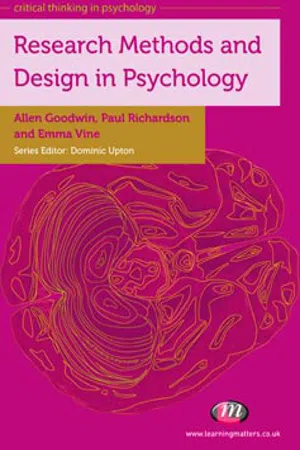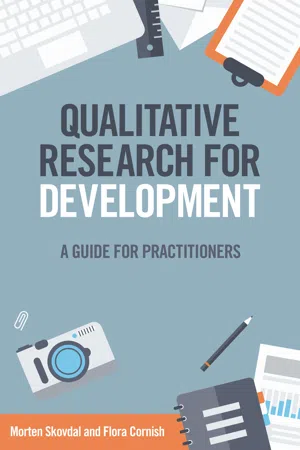Designing Research
Designing research in psychology involves planning and structuring studies to investigate specific phenomena or questions. This includes defining research questions, selecting appropriate methods, and considering ethical implications. The design process aims to ensure that the study is valid, reliable, and can provide meaningful insights into the psychological phenomena under investigation.
5 Key excerpts on "Designing Research"
- eBook - ePub
- Diana Jackson-Dwyer, Craig Roberts(Authors)
- 2015(Publication Date)
- Psychology Press(Publisher)
...12 Research in Psychology What's it about? This chapter covers all the research methods in psychology and the issues that arise from them. A lot of this you will have covered as you revised the other chapters, so hopefully this will not be unfamiliar to you. The Unit 3 exam is devoted to research methods but additional questions on this topic will appear throughout all the exam papers, so be prepared for that. What's in this Unit? The specification lists the following things that you will need to be able to do for the examination: Planning research ■ Hypotheses ■ Variables ■ Experimental design ■ Sampling techniques ■ Ethical considerations Doing research ■ Experiments ■ Questionnaires ■ Interviews ■ Observations ■ Types of studies Analysing research ■ Types of data ■ Descriptive data ■ Tables, charts and graphs ■ Evaluating findings ■ Sources of bias Planning an investigation ■ Investigation skills ■ Design skills Planning research Hypotheses When a psychological investigation is done, the researcher starts with an aim and a hypothesis. The aim of a study is usually one sentence that clearly highlights what the researcher is intending to investigate. The hypothesis is a prediction. It is a sentence that states what the researcher predicts the findings could be. The investigator starts with two different hypotheses: • An alternative hypothesis states that there will be a difference between two sets of scores, or a correlation between them (depending on the type of study that was done). It is a clear specific statement such as: “Children who have watched an aggressive model will show a greater number of aggressive acts than children who have watched a non-aggressive model.” • A null hypothesis states that there will be no difference or relationship between two sets of scores...
- eBook - ePub
- Paul Richardson, Allen Goodwin, Emma Vine(Authors)
- 2011(Publication Date)
- Learning Matters(Publisher)
...Chapter 1 Designing psychological research studies Learning outcomes This chapter will outline the phases and problems associated with the early stage of conducting research. It will take you through the process of finding, defining and designing a research question and highlight the factors that need to be considered. By the end of this chapter you should: – understand the stages involved in setting up a research study; – be able to undertake the process of finding, defining and designing a research study; – understand the importance of a literature review in the process of conducting research; – understand the need for a formal operationalisation of the research question; – be aware of the problems of capturing a measure; – be aware of the issues of validity, reliability and confounds. Introduction The statement that ‘Good researchers are made, not born’ is worth keeping in mind when you approach the design of research studies. Far too often it is assumed that the ability to conduct research is somehow innate or easy. The truth is far more brutal – good research is a process based on acquired knowledge and experience. In order to make this whole process less daunting, we can start by fragmenting the research process into discrete steps. The reasons are twofold. The first is that to approach the process as a whole entity may be beyond our cognitive ability (there are only a limited number of cognitive balls that we can juggle). Secondly, through the categorisation of each stage, we can minimise errors that we may make along the way. It is important to realise that the use of the most sophisticated statistical analysis does not compensate for a badly framed research question or poor methodology, as these invalidate any statistical finding. Always remember that the statistical analysis conducted on the data obtained is only as good as the quality of the data...
- eBook - ePub
- Hennie R Boeije(Author)
- 2009(Publication Date)
- SAGE Publications Ltd(Publisher)
...Of course, the chosen research approach (see Chapter 1) will determine what needs to be done during analysis. When, for example, one is aiming for an ethnographic study, a study using conversation analysis or a case-study, the relevant methodologies prescribe certain procedures. When the purpose is to generate a grounded theory about a basic human psychosocial experience, you might say something about the concepts you are probably going to use in the analysis and how you will approach the analysis, for instance how coding will be employed and which software for qualitative analysis will be used (see Chapters 6 and 7). An essential part of your analytic plan in the research proposal is to indicate to reviewers that data collection and data analysis alternate in qualitative research. This is a vital part of the qualitative research procedure, and one of the main reasons that not all parts of the research can be planned in advance (Bruce, 2007). In the design stage you need to indicate how you plan for the interchange of data collection and data analysis and in how many cycles you plan to finish. For example, you may plan to observe two school classes, analyse the data and then search for two new classes. You plan to do so in three rounds until you have a minimum of six classes. If that turns out not to be enough, your plan will include the search for more classes (see last section of this chapter). However, as Patton (1999) acknowledges, research proposals are judged not only on the use of rigorous techniques and methods for gathering data and careful analysis, but also on the credibility of the researcher, which includes training, experience, track record, status and presentation of self (Chapter 9). Moreover, the quality issue is related to the philosophical belief in the value of qualitative inquiry (see Chapters 1 and 8)...
- eBook - ePub
The Designer's Guide to Doing Research
Applying Knowledge to Inform Design
- Sally Augustin, Cindy Coleman(Authors)
- 2011(Publication Date)
- Wiley(Publisher)
...Scientists have learned, for example, all sorts of things about how the wording and structure of survey questions influences the information collected—and we’ll present a reasonable number of those rules. When doing a visual content analysis of the living spaces favored by future residents of a place under development, there are fewer operational rules to report, although both techniques are rigorous and respected in the research world. Any research effort needs to be coordinated between teammates. The research plan needs to identify the person or persons who will ultimately be responsible for organizing and executing particular research activities. Designating responsible parties makes it easier for people not initially involved with research activities to join the research efforts, or to understand activities undertaken by the research team. Clearly defining the roles of everyone involved in the research project prevents confusion over responsibilities and streamlines the research process. A coordinated plan establishes when, how, by whom, and where information is collected, analyzed, stored, and applied. A research plan makes researchers feel more comfortable that they will achieve their objectives; gives them confidence, and credibility among the project stakeholders and sponsors of the research; and provides valuable information that informs and brings greater certainty to a design response. Overview of Types of Research Research tools can be divided into categories using several sorts of criteria. Often, people use the terms qualitative and quantitative to define research types. There are many techniques that fall into each of these broad buckets. Qualitative techniques include interviewing, discussion groups, and observing. Experiments, surveying, and behavior mapping are examples of quantitative techniques. Quantitative tools more clearly establish the information that will be collected, while qualitative techniques are more open ended...
- eBook - ePub
- Morten Skovdal(Author)
- 2015(Publication Date)
- Practical Action Publishing(Publisher)
...Even the most experienced qualitative researchers feel overwhelmed by all the things they need to consider in order to plan and set up a study. This chapter offers guidance on some of the many aspects of qualitative research that you will need to consider and plan for before you start. These include, but are not limited to: • deciding on a research focus and refining research questions; • selecting an appropriate study design that can answer your research questions; • thinking about a qualitative analysis strategy that can shed light on the topic under investigation; • setting up a study team, including researchers and members for an advisory group; • identifying suitable research methods; • agreeing on who the study participants should be as well as how to select them; • considering ethical implications for study participants; • developing a plan for how best to communicate study findings to inform future programming; and • considering what is possible within the limits of time, money, and staff competencies. Whether you will be conducting the research yourself, writing ‘terms of reference’ for a consultant, or managing a qualitative study as part of your job, these are some of the things you will need to consider before you get started. Such planning is often done through the development of a study protocol. A study protocol is a document that describes the general design and operating features of your qualitative study. In other words, a study protocol makes explicit your plans and considerations for using qualitative research methods. A study protocol, however, is not merely a document that describes your planned research activities; it is an instrumental tool in the development of a study in that it encourages you to think carefully about how all the elements of your study fit together...




